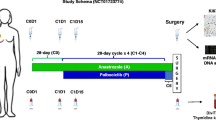Abstract
Purpose: To develop, using dacarbazine as a model, reliable techniques for measuring DNA damage and repair as pharmacodynamic endpoints for patients receiving chemotherapy. Methods: A group of 39 patients with malignant melanoma were treated with dacarbazine 1 g/m2 i.v. every 21 days. Tamoxifen 20 mg daily was commenced 24 h after the first infusion and continued until 3 weeks after the last cycle of chemotherapy. DNA strand breaks formed during dacarbazine-induced DNA damage and repair were measured in individual cells by the alkaline comet assay. DNA methyl adducts were quantified by measuring urinary 3-methyladenine (3-MeA) excretion using immunoaffinity ELISA. Venous blood was taken on cycles 1 and 2 for separation of peripheral blood lymphocytes (PBLs) for measurement of DNA strand breaks. Results: Wide interpatient variation in PBL DNA strand breaks occurred following chemotherapy, with a peak at 4 h (median 26.6 h, interquartile range 14.75–40.5 h) and incomplete repair by 24 h. Similarly, there was a range of 3-MeA excretion with peak levels 4–10 h after chemotherapy (median 33 nmol/h, interquartile range 20.4–48.65 nmol/h). Peak 3-MeA excretion was positively correlated with DNA strand breaks at 4 h (Spearman's correlation coefficient, r=0.39, P=0.036) and 24 h (r=0.46, P=0.01). Drug-induced emesis correlated with PBL DNA strand breaks (Mann Whitney U-test, P=0.03) but not with peak 3-MeA excretion. Conclusions: DNA damage and repair following cytotoxic chemotherapy can be measured in vivo by the alkaline comet assay and by urinary 3-MeA excretion in patients receiving chemotherapy.
Similar content being viewed by others
Author information
Authors and Affiliations
Additional information
Received: 20 April 1999 / Accepted: 11 June 1999
Rights and permissions
About this article
Cite this article
Braybrooke, J., Houlbrook, S., Crawley, J. et al. Evaluation of the alkaline comet assay and urinary 3-methyladenine excretion for monitoring DNA damage in melanoma patients treated with dacarbazine and tamoxifen. Cancer Chemother Pharmacol 45, 111–119 (2000). https://doi.org/10.1007/s002800050018
Issue Date:
DOI: https://doi.org/10.1007/s002800050018




